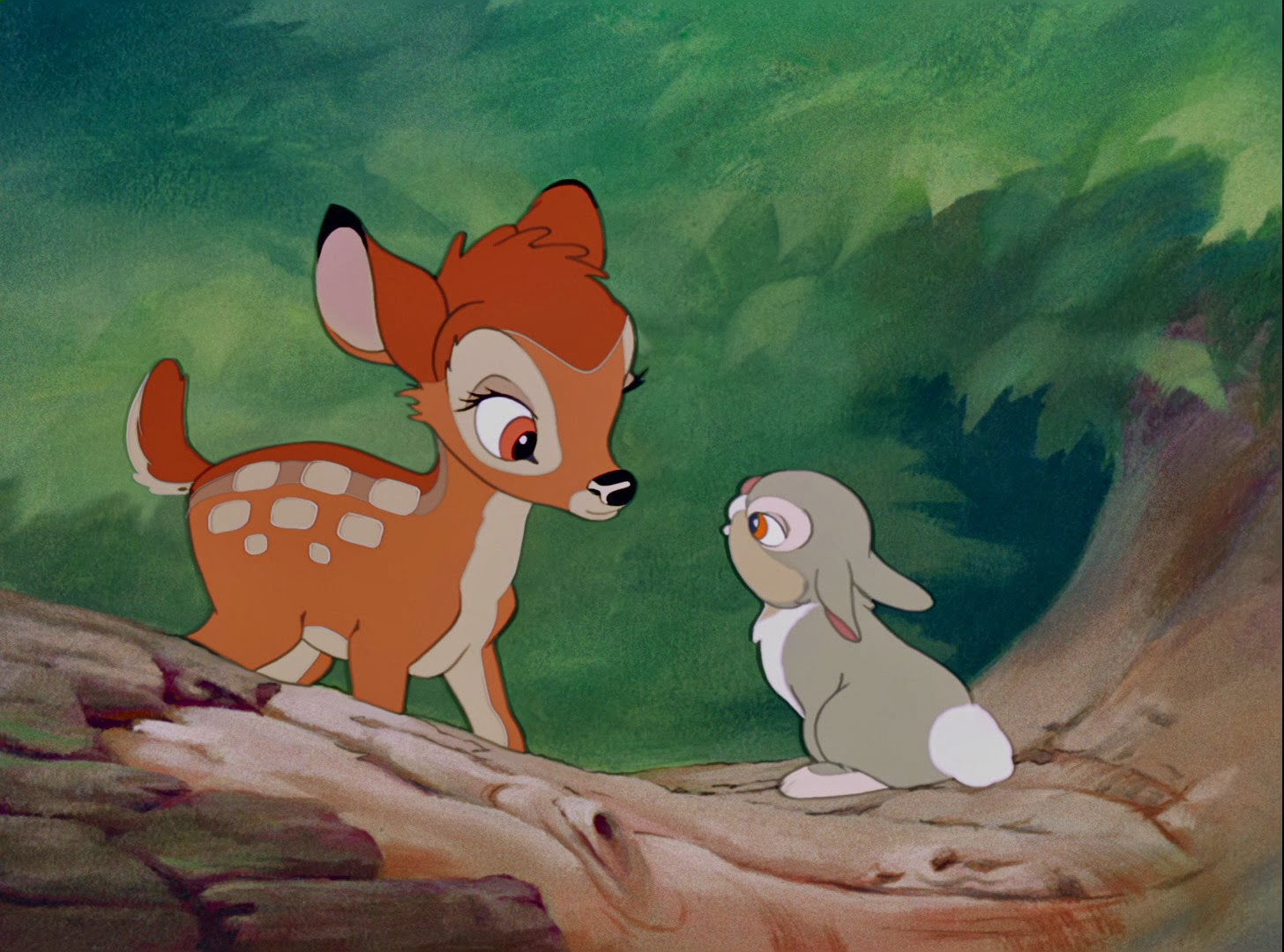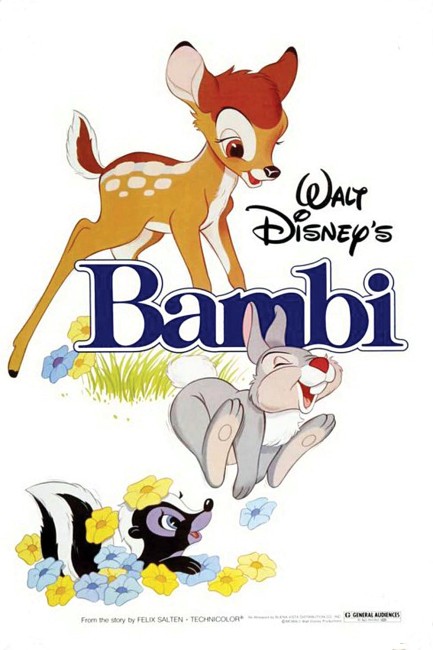USA. 1942.
Crew
Supervising Director – David C. Hand, Story Director – Perce Pearce, Story Development – Chuck Couch, Carl Fallberg, Melvin Shaw, George Stallings & Ralph Wright, Story Adaption – Larry Morey, Based on the Book by Felix Salten, Music – Frank Churchill & Edward Plumb, Music Orchestration – Paul J. Smith & Charles Wolcott, Music Conductor – Alexander Steinert, Choral Arrangements – Charles Henderson, Sequence Directors – James Algar, Sam Armstrong, Graham Heid, Bill Roberts, Paul Satterfield & Norman Wright, Animation Supervisors – Oliver M. Johnston Jr, Milton Kahl, Eric Larson & Franklin Thomas, Art Direction – Thomas H. Codrick, Robert C. Cormack, Lloyd Harting, David Hilberman, John Hubley, Dick Kelsey, McLaren Stewart & Al Zinner. Production Company – Disney.
Plot
A young fawn, Bambi, is born and innocently makes his way, trying to understand life in the forest. Bambi’s mother is then killed by a human hunter. Bambi grows into adulthood and soon comes to find love, although the ever-present threat of the human hunter lurks.
Bambi is considered by many to be the finest animated films ever made by Disney. It is not quite – that is a privilege reserved for Fantasia (1940). However, it is undeniably one of the great classics of Disney animation. At the time it was made, the feature-length animated film was still a relatively new form – this was only the fifth feature-length film Disney had made and the total number of animated feature films made in the world up to the point could still be counted on two hands. Despite this, it already shows Disney reaching for extraordinary artistic heights.
You can’t help thinking how much more dazzling Bambi would have been if some of the sequences like the stampede of the bucks had been conducted with today’s arrays of CGI-driven animated wonderment, nevertheless there is extraordinary beauty to much of the animation on display – rainstorms where we follow drops gently falling from leaf to leaf and pairs of leaves conducting delicate dances toward the ground or images reflected in rippling ponds. The fights with dogs and the elk and the flight from the forest fire are conducted with an immense degree of excitement.
Noticeably, in contrast to Disney’s previous films that had featured talking animals such as Snow White and the Seven Dwarfs (1937), Pinocchio (1940) and Dumbo (1941), not to mention the numerous Donald Duck and Mickey Mouse shorts, this stresses a realistic portrayal of wildlife fauna – the animators went and carefully modelled real deer in order to make Bambi’s movements believable.

Of course, the real delight of Bambi is its unalloyed innocence. The Disney penchant for wide-eyed, child-like anthropomorphism reaches its most unabashed and shameless heights here – the character of Bambi and the way it is drawn is played for as much soft, doe-eyed sympathy as it possibly can. (Indeed, you not might be mistaken in thinking that the term ‘doe-eyed’ was derived solely as an adjective to characterize Bambi). The film almost entirely consists of a series of contrasts between the child-like innocence of Bambi up against the larger world. The heart-tugging appeal of the film is in seeing the innocent child creature uncomprehendingly stumble into dangers that we can perceive but it doesn’t.
The one scene that everybody remembers is the shooting of Bambi’s mother. It is a shattering scene – surely something that any modern Disney film would be too afraid to ever pull on its kids. It is all the more powerful for its focus on the naivete and incomprehension of Bambi – the scene is concentrated on Bambi’s flight away from the hunter, then comes the ringing out of the shot, followed by Bambi’s excited “We made it” and the slow sinking in of what the lack of reply from his mother means. We never see the shooting yet the effect is incredibly powerful. Indeed, we never even see the human hunters throughout the film – and despite which Bambi may end up being the greatest piece of free PR the Animal Rights campaigners ever had.
The film never develops a plot. It is more a series of scenes and its resolution is on a giggly cornucopic delirium that passes for a Disney anthropomorphized animals version of spring with Bambi finding romance and becoming a father. This latter may well make it the only Disney film to feature a rite of passage and allow its lead character to travel from being a perpetual child into adulthood.
Amid the process of Disney sequelizing all their animated films during the 1990s-00s, a Bambi sequel was produced with Bambi II (2006).
Trailer here


